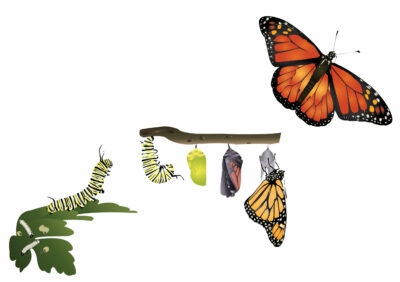The monarch butterfly has four distinct life stages: egg, larva (caterpillar), pupa (chrysalis), and adult.
- EGG: A female Monarch butterfly lays from 100 to 300 eggs during her life. The eggs hatch about four days after they are laid.
- LARVA: When larvae first hatch they are less than 1 centimeter (cm) and grow to be about 5 cm. The stages between larval molts are called instars and they go thru 5 stages, shedding their skin at each stage. This stage ranges between 10 and 14 days
- PUPA: The monarch develops from a pupa to an adult in 10 to 18 days. The completion of the four life-stage process is called complete metamorphosis.
- ADULT: The emergence of the butterfly from the pupal stage to an adult is called eclosion. The Monarch Butterfly can live up to 9 months
Source: Monarch Watch
The Migration takes multiple Generations
That’s right.
Monarch migration happens over “generations” meaning they produce offspring, that produce off spring, that take on the herculean journey.
During the summer breeding season, monarchs live from 2-5 weeks during which they mate and lay the eggs that become the next generation. The last generation of the year does not become reproductive and is said to be in “reproductive diapause”.
These butterflies are the ones that migrate to Mexico where they overwinter. These butterflies become reproductive in February and March as they move north, laying eggs on milkweeds as they progress northward into the United States. Some of these butterflies can live as long as 9 months!
Monarchs have up to four generations each summer, each one traveling a little further north than the last. The last generation of the year migrates south.
US Forest Service, United States Department of Agriculture
One unique aspect of the monarch butterfly’s life cycle is its migratory behavior. Monarchs in North America belong to two distinct populations: eastern and western. Eastern monarchs breed in the southern US and migrate to Mexico for the winter, while western monarchs breed in California and overwinter along the California coast. The migration is multigenerational, with the overwintering generation returning north in the spring to lay eggs, followed by several subsequent generations that continue the migration north. The final generation of the season migrates back to the wintering grounds, where they spend the winter in a state of reproductive diapause.
The migratory generation has an enormous task ahead of them. Weighing less than a gram, these unique butterflies will fly between 2,000 to 3,000 miles to an overwintering location in Mexico.
The life cycle of a monarch butterfly is an incredible journey that spans multiple generations and thousands of miles. From the laying of an egg on a milkweed leaf, to the transformation into a beautiful butterfly, to the multigenerational migration to overwintering grounds, the monarch butterfly represents one of nature’s most impressive and well-known cycles of life.


